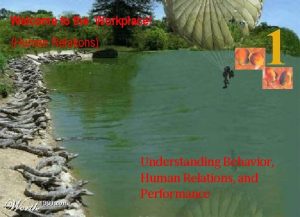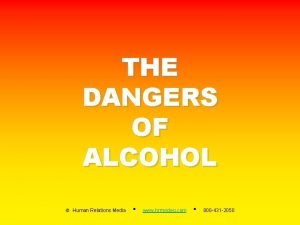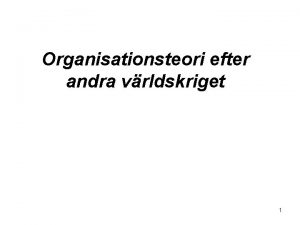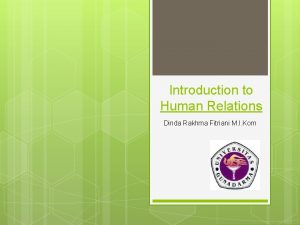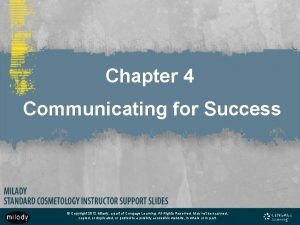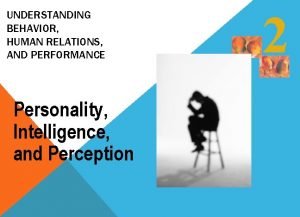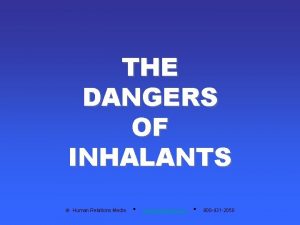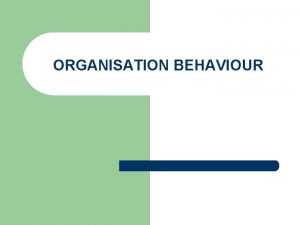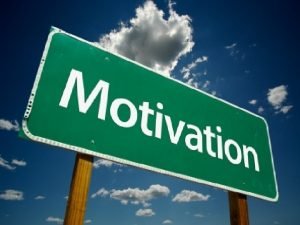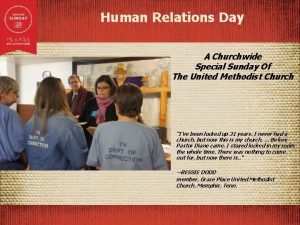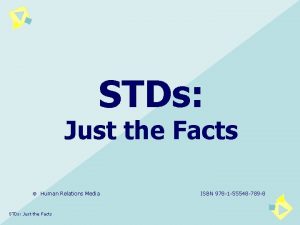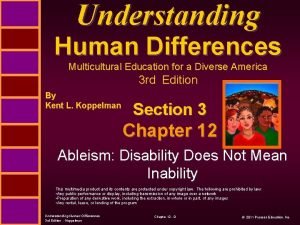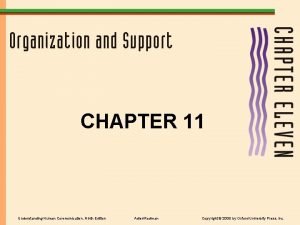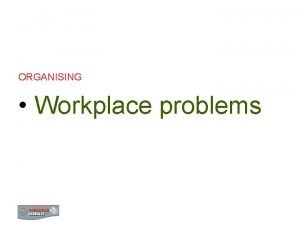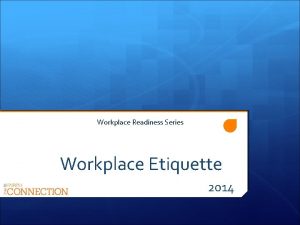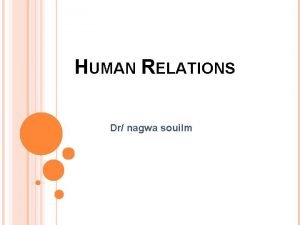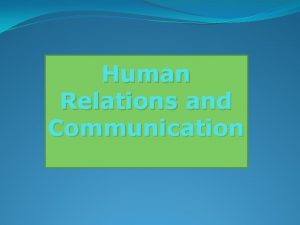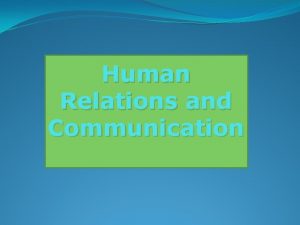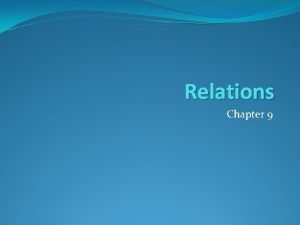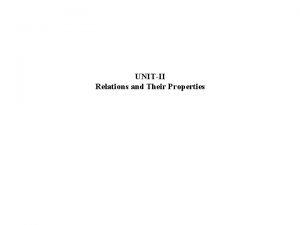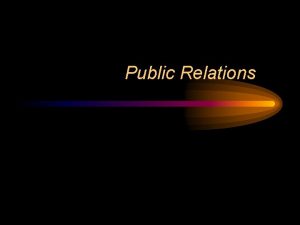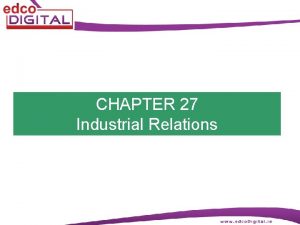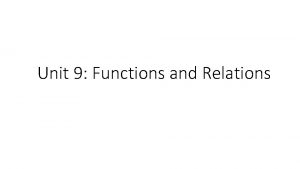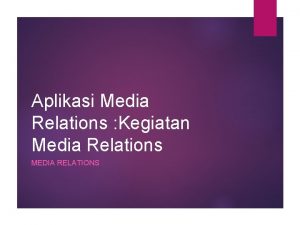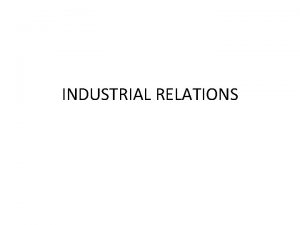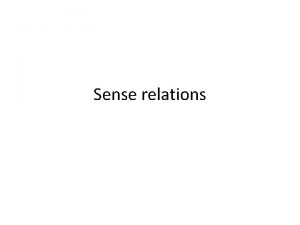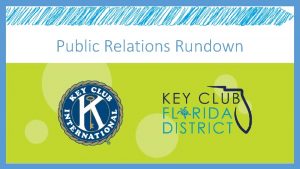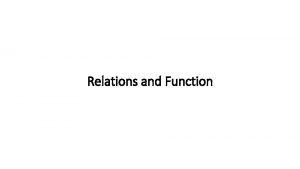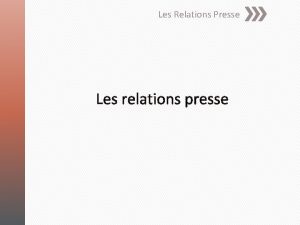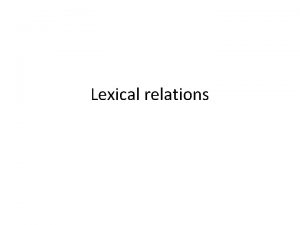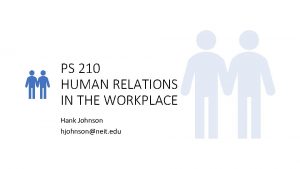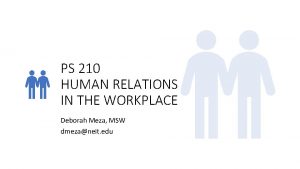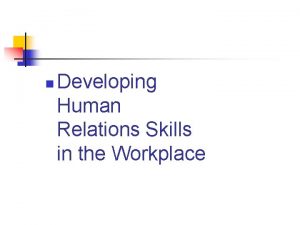Welcome to the Workplace Human Relations 1 Understanding



































- Slides: 35

Welcome to the Workplace! (Human Relations) 1 Understanding Behavior, Human Relations, and Performance

Why Human Relations? • People are the most important resource. • Single biggest reason for career success and failure. • Time spent in resolving employee clashes. • Important factor in global competition. • Affects productivity. • Managers work with people.

The Goal of Human Relations to create a win-win situation by satisfying employee needs while achieving organizational objectives.

First Time Management Roles

Here’s the situation • You’re a new manager in a key position to the company. • You now have 35 people reporting to you. • You’re still learning the business and the roles of those employees who report to you. • You are unaware of the dynamics within the organization. • What are your first steps?

Laundry List • Give yourself at least 6 – 12 months before making changes. • In that time, you need to accomplish the following: • Learn the dynamics of the organization • Evaluate the job descriptions of those working for you; are they in compliance? Do they reflect the job? • Develop performance evaluation criteria • Evaluate the wage scales for equity. When was the last time employees received a raise? What criteria was used?

Laundry List Continued • Give yourself at least 6 – 12 months before making changes. • In that time, you need to accomplish the following: • Learn the interpersonal dynamics of those who work for you. • Develop rapport and trust of those who work for you. Establish yourself as a leader. • Develop mission and vision of where the department is going.

Job Fit? Total person approach: the organization employs the whole person, not just his or her job skills. • Does the individual fit within the organization? Culture? • You get the whole person – not just one aspect of that individual. • Can the individual separate work from personal problems? • From a legal standpoint – Does the person create a hostile work environment for others because of personal issues outside or in the workplace?

TERMS YOU NEED TO KNOW… Organization: a group of people working to achieve an objective. Organizational behavior: the collective behavior of the organization’s individuals and groups. Performance: the extent to which expectations or objectives have been met. Systems effect: all people in the organization are effected by at least one other person, and each person affects the whole group/organization.

Behavior: what people do and say Board of Directors President V. P. Marketing Example level 3: Organizational behavior V. P. Production Managers Supervisors Employees V. P. Finance Example level 1: Individual behavior Example level 2: Group behavior

Relationship Among Individual, Group, and Organizational Performance Organization Individual n rga O Group Org ion t a z i aniz Group Individual Ineffective individuals atio n Individual Group Ineffective groups

The Systems Approach: …we affect everyone else’s performance Performance Behavior Human relations ce Perfo rman ce an m r o f Per Human relations Behavior Ineffective behavior Behavior Human relations Ineffective human relations

How likeable are you? Rank each question from 1 -5 “ 5” usually, “ 3” occasionally, “ 1” rarely 1. I’m an optimist. I look for the good in people and situations, rather than the negative. 2. I avoid complaining about people, things, and situations. 3. I show a genuine interest in other people. I compliment them on their success. 4. I smile. 5. I have a sense of humor. I can laugh at myself. 6. I make an effort to learn people’s names and address them by name during conversations. 7. I truly listen to others. 8. I help other people cheerfully. 9. I think before I act and avoid hurting others with my behavior. 10. If I were to ask all the people I work/worked with to answer these nine questions for me, they would select the same responses that I did.

The Nine Human Relations Guidelines 1. 2. 3. 4. 5. 6. 7. 8. 9. Be Optimistic. Be Positive. Be genuinely interested in people. Smile and develop a sense of humor. Call people by name. Listen to people. Help others. Think before you act. Create a win-win situation.

Understanding Behavior, Human Relations and Performance – From a Scientific Analysis

• Human Relations: Past, Present and Future Scientific Management Fredrick W. Taylor Late 1800’s early 1900’s Mass Production Time Motion studies “one best way” Focus on Production and quotas, not people Assumed Money was Key with workers

FREDERICK TAYLOR’S - SCIENTIFIC MANAGEMENT - TIME PERIOD = 1930’s 1. IDENTIFY THE ONE BEST WAY TO DO A JOB. 2. SELECT AND HIRE THE BEST SUITED PERSON. 3. TRAINING OF EACH WORKER - HE OR SHE KNEW PRECISELY HOW TO ACCOMPLISH THE WORK/TASK. 4. A HIGH DEGREE OF COOPERATION BETWEEN LABOR AND MANAGEMENT.

Pit Falls of Taylor’s Work • Failed to recognize the social needs of employees. • Employees were isolated in the jobs. • Not in touch with human behavior • Workers working conditions were not considered.

IN CONTRAST TO FREDERICK TAYLOR’S - SCIENTIFIC MANAGEMENT BUREAUCRACY - 1. TASKS ARE DIVIDED INTO HIGHLY SPECIALIZED JOBS - WORKERS ARE EXPECTED TO ONLY PERFORM THOSE TASKS OUTLINED TO THEM AT THE DATE OF HIRE. 2. “PARK YOUR BRAIN AT THE DOOR” - ATTITUDE 3. HIGHLY RIGID HIERARCHY WITH A CLEAR DEFINITION OF REPORTING - LINES OF AUTHORITY

IN CONTRAST TO FREDERICK TAYLOR’S - SCIENTIFIC MANAGEMENT BUREAUCRACY - 2. “PARK YOUR BRAIN AT THE DOOR” - ATTITUDE 3. HIGHLY RIGID HIERARCHY WITH A CLEAR DEFINITION OF REPORTING - LINES OF AUTHORITY

BUREAUCRACY (Continued)- 4. CLOSED DOOR POLICY - CLOSED ENVIRONMENT 5. INITIAL PLACEMENT AND ADVANCEMENT IN ORGANIZATION IS BASED ON MERIT AND QUALIFICATIONS ONLY. 6. CREATIVITY IS A THREAT TO ALL SYSTEMS

• Robert Owen 1800’s – 1920’s The first manager-entrepreneur to understand need to improve work environment and overall situation Called “father of personnel administration” Profit based on employee environment, situation Against child labor of children under the age of 11. Cleanliness and order

n. The Hawthorne Studies 1927 – 1932 Elton Mayo Human Relations Movement Employees have many needs beyond those satisfied by money. Internal work groups have powerful influence. Many employee needs are satisfied off the job. Employee relations affect employee performance.

Western Electric Hawthorne Studies Mid 1920’s – 1930’s • the scope of the study was expanded to discover relationships between working conditions, industrial productivity, and such additional variables as worker morale, home life, upbringing, diet, and other habits. This was largely achieved through guided and openended interviews and transcripts of test room conversation. Between 1928 and 1930, approximately 21, 000 employees of the Hawthorne Plant granted interviews to the research team.

HAWTHORNE EFFECT STUDIES BY ELTON MAYO “Father of Human Relations”. . . OCCURS WHEN PEOPLE ARE INFLUENCED BY RECOGNITION TO PERFORM AT A HIGHER LEVEL THAN THEY MIGHT OTHERWISE.

W. Edwards Deming 1950’s Dr. W. Edwards Deming is known as the father of the Japanese post-war industrial revival and was regarded by many as the leading quality guru in the United States. He passed on in 1993. Trained as a statistician, his expertise was used during World War II to assist the United States in its effort to improve the quality of war materials. He was invited to Japan at the end of World War II by Japanese industrial leaders and engineers. They asked Dr. Deming how long it would take to shift the perception of the world from the existing paradigm that Japan produced cheap, shoddy imitations to one of producing innovative quality products. http: //www. lii. net/deming. html

His Answer…. • Dr. Deming told the group that if they would follow his directions, they could achieve the desired outcome in five years. Few of the leaders believed him. But they were ashamed to say so and would be embarrassed if they failed to follow his suggestions. As Dr. Deming told it, "They surprised me and did it in four years. "

“IF JAPAN CAN, WHY CAN’T WE? ” W. EDWARDS DEMING 14 STEPS MANAGEMENT MUST TAKE 1. CREATE CONSTANCY OF PURPOSE TOWARDS IMPROVING PRODUCT AND SERVICE. 2. ADOPT THE NEW PHILOSOPHY: AWAKEN TO THE CHALLENGE; LEARN RESPONSIBILITIES; TAKE ON LEADERSHIP IN ORDER TO BRING ABOUT CHANGE. 3. CEASE DEPENDENCE OF INSPECTION TO ACHIEVE QUALITY.

4. END THE PRACTICE OF AWARDING BUSINESS ON THE BASIS OF THE PRICE TAG. INSTEAD MINIMIZE TOTAL COST. MOVE TOWARDS A SINGLE SUPPLIER AND DEVELOP LONG-TERM RELATIONSHIPS. GOAL= J. I. T. 5. IMPROVE CONSTANTLY AND FOREVER THE SYSTEMS OF PRODUCTION AND SERVICE IN ORDER TO IMPROVE QUALITY.

INSTITUTE TRAINING ON THE JOB. INSTITUTE LEADERSHIP DRIVE OUT FEAR BREAK DOWN BARRIERS BETWEEN DEPARTMENTS 10. ELIMINATE SLOGANS, EXHORTATIONS, TARGETS THAT DEMAND ZERO DEFECTS AND NEW LEVELS OF PRODUCTIVITY.

11. ELIMINATE WORK STANDARDS (QUOTAS) AND SUBSTITUTE THEM WITH LEADERSHIP. ELIMINATE MANAGEMENT BY OBJECTIVES. 12. REMOVE BARRIERS THAT ROB THE HOURLY WORKER OF HIS RIGHT TO PRIDE OF WORKMANSHIP. 13. INSTITUTE A VIGOROUS PROGRAM OF EDUCATION AND SELF-IMPROVEMENT 14. PUT EVERYBODY IN THE COMPANY TO WORK TO ACCOMPLISH THE TRANSFORMATION. . .

THE TRANSFORMATION IS EVERYONE’S JOB”

Human Relations: Past, Present, and Future … • 1930 s and 1940 s : Unions forced management to recognize employee needs • 1960 s: Theory X & Y developed by Douglas Macgregor while Eric Berne introduced Transactional Analysis. • 1970 s: Human relations began to be called organizational behavior. Americans began to look to their competition for ways to increase performance. • 1980 s: William Ouichi developed Theory Z Douglas Macgregor William Ouichi

Human Relations: Past, Present, and Future • 1980 s: In Search of Excellence • Peters and Waterman researched the characteristics of successful organizations: • They have a bias for action. • They are close to the customer. • They are use autonomy and entrepreneurship. • They attain high producti vity through people. • They are hands-on and value-driven. Tom Peters • They stick to the knitting and do not diversify greatly. • They use a simple organizational form with a lean staff. • They have simultaneous loose-tight properties. • 1990 s: • Worker involvement dominates human resource issues.

Trends and Challenges • External Environmental Forces • Litigation • A service economy • A global economy • Quality and productivity • Cost and reorganization’ • Innovation and speed • • Diversity • Race/ethnicity • An aging work force • Sex • Family • Changing educational levels Technology l Involvement with computers l Virtual offices l Telecommunications l Telecommuting
 Understanding human relations
Understanding human relations Employee relations in public relations
Employee relations in public relations Wise men three clever are we
Wise men three clever are we Lethal bac levels
Lethal bac levels Mayo theory
Mayo theory Human relations organisationsteori
Human relations organisationsteori Teoria human relations
Teoria human relations Scope of human relations
Scope of human relations Milady client consultation form
Milady client consultation form Personality and human relations
Personality and human relations Human relations media
Human relations media Advantages of division of labour
Advantages of division of labour Negative reinforcement
Negative reinforcement Human relations day
Human relations day Human relations media
Human relations media Understanding human differences 5th edition
Understanding human differences 5th edition Adler and rodman 2006
Adler and rodman 2006 Understanding human communication 14th edition
Understanding human communication 14th edition Hát kết hợp bộ gõ cơ thể
Hát kết hợp bộ gõ cơ thể Ng-html
Ng-html Bổ thể
Bổ thể Tỉ lệ cơ thể trẻ em
Tỉ lệ cơ thể trẻ em Gấu đi như thế nào
Gấu đi như thế nào Tư thế worms-breton
Tư thế worms-breton Chúa yêu trần thế alleluia
Chúa yêu trần thế alleluia Các môn thể thao bắt đầu bằng tiếng chạy
Các môn thể thao bắt đầu bằng tiếng chạy Thế nào là hệ số cao nhất
Thế nào là hệ số cao nhất Các châu lục và đại dương trên thế giới
Các châu lục và đại dương trên thế giới Công thức tiính động năng
Công thức tiính động năng Trời xanh đây là của chúng ta thể thơ
Trời xanh đây là của chúng ta thể thơ Mật thư anh em như thể tay chân
Mật thư anh em như thể tay chân Phép trừ bù
Phép trừ bù Phản ứng thế ankan
Phản ứng thế ankan Các châu lục và đại dương trên thế giới
Các châu lục và đại dương trên thế giới Thơ thất ngôn tứ tuyệt đường luật
Thơ thất ngôn tứ tuyệt đường luật Quá trình desamine hóa có thể tạo ra
Quá trình desamine hóa có thể tạo ra
